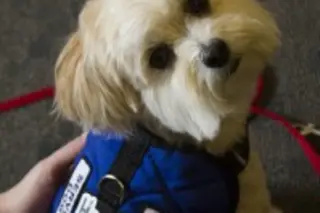Photo: Flickr/Quinn Dombrowski
Guide dogs help their blind owners in amazing ways, from navigating public transportation to preventing them from crossing streets in traffic. It's clear that the dogs know what they need to do, but do they know why they are needed? To answer this question, a French anthropologist filmed guide dogs and pet dogs "asking" their owners for food. Both groups of dogs used visual cues to indicate their desire for food by looking back and forth between the food dish and the owner. Because the guide dogs continued to use sight-based communication, the author reasoned that they do not understand that their owners cannot see them. However, the guide dogs did learn that sounds can help them communicate with their owners, and they licked their chops more frequently than the dogs of sighted owners (an auditory cue). We wonder if they used their guilty look less often ...














